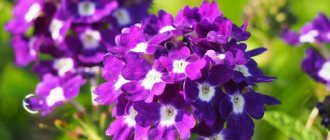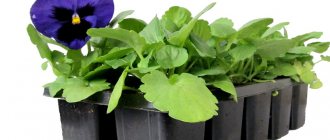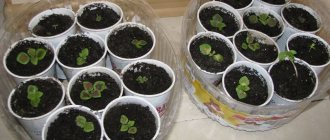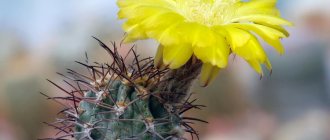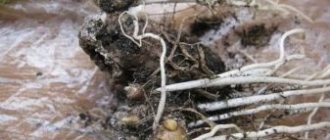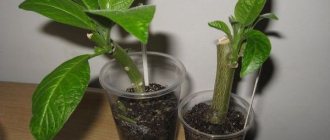Description of rock alyssum
This herbaceous plant is found in the mountainous regions of Europe and the shores of the Mediterranean Sea. A flowering perennial up to 30 cm high, it is densely covered with yellow four-petaled flowers collected in brushes. A bushy plant with semi-lignified shoots blooms in early spring. Rock alyssum has pubescent thin leaves of a bluish-gray hue. The delicate aroma of the plant is attractive to bees. By autumn, small flat achenes ripen in the pods. The root system of the crop is compact
Allisum after flowering
Collecting seeds
Seeds are collected at the end of September or beginning of October on a dry, windless day. A cloth is spread on the ground, the inflorescences are picked up and thoroughly rubbed. Next, large debris is removed, and small debris can be left. For drying, seeds are kept in a dry place with good ventilation, but without drafts. The seeds are poured into a fabric bag and left until spring. If the seeds spill onto the ground, they are carefully swept out from under the bushes with a broom, the debris is removed and stored.
Wintering perennial
Alyssum is moderately resistant to wintering and if the air temperature drops below 15 degrees, the plant will die. In regions with mild winters, with proper preparation, this flower will calmly survive the cold months. In late autumn, the area is covered with dry leaves. Next, they throw a snowdrift when the snow falls. In this way, the alyssum will be able to survive the winter and maintain green foliage.
It is not recommended to prune the plant before winter; it is better to do it in the spring.
Watch the video! Alyssum - cultivation and care
Popular varieties
Some types of alyssum bloom in shades of pink and purple. Rock alyssum flowers are predominantly yellow. Even the names of the varieties contain references to the golden shades of lush flowering.
Alyssum rocky Golden wave
The Golden Wave rock alyssum bushes live up to their name. Many bright inflorescences of golden yellow color cover lush bushes with a diameter of about 40 cm and form a wavy cushion. The height of this variety of alyssum can reach no more than 25 cm. When grown as seedlings, rocky alyssum Golden Wave blooms a little later than a month after placement in the flowerbed. When favorable conditions are created, flowering lasts almost all summer. The silvery foliage is no less decorative than the flowers.
Alyssum rocky Gold placer
Gardeners classify the Golden Placer variety as a ground cover. Lush bushes about 15-20 cm high are covered with yellow flowers. The strongly branched plant quickly grows throughout the entire space. The Golden Placer blooms from May to the end of June. By creating optimal conditions and timely pruning, you can get secondary flowering closer to autumn.
Alyssum rocky Inca gold
A perennial covered with many yellow fragrant flowers, it has small inflorescences. Strongly branched bushes with bluish pubescent small leaves are used as a ground cover plant.
Alyssum rocky Mountain gold
The low-growing perennial variety Mountain Gold forms a bright carpet in the flowerbed. The bushes of a flowering plant with lodging shoots are covered with small lush inflorescences until frost.
Alyssum rock Aphrodite
One of the few varieties of rock alyssum, whose flowers are purple, red and pinkish, is grown as an annual crop. The plant blooms from June to October, and in some regions even longer. The low-growing, branched plant has many simple flowers in lush clusters.
Alyssum rocky yellow
One of the shortest varieties of rock alyssum, the height of the bushes rarely reaches more than 10 cm. A branched plant with recumbent and ascending shoots develops well in sunny areas with rocky, acidic soil.
Plant characteristics
The perennial Alyssum rocky grows in a hemispherical shape, in the form of ornamental plants up to 45 cm high. It has branched branches that become woody at the base.
The foliage of the bush is gray and slightly fluffy. The bush blooms with small yellow flowers. Alyssum rock has a subtle honey scent that attracts bees.
Each flower has 2 pairs of sepals, which are arranged in a checkerboard pattern.
In autumn, Alyssum rocky produces small fruits, similar to pods, which contain seeds.
The decorative flower grows in Europe and southern Siberia. The bushes begin to bloom in spring. The period of active flowering is 35 days. Towards the end of August, you can see the buds blooming again.
Rocky alyssum is a plant that appeared even closer to the 18th century. Thanks to this, it is well studied by scientists. Has a laxative and diuretic effect.
Alyssum rocky flowers are used to decorate the garden and arrange them into beautiful flower beds. The plant is not afraid of low temperatures. It can grow well down to -15 degrees, but is very demanding on proper lighting.
Landing Features
Gardeners consider rock alyssum an unpretentious herbaceous plant suitable for open ground. It can grow in one place for several years without transplantation, requiring almost no care. But in order to create a neat flowering flowerbed that will delight you all summer, you need to follow some rules.
Site selection and preparation
To plant rock alyssum, you need to choose a place that is illuminated most of the day. In the southern regions, it is possible to plant flowers in partial shade. In nature, rock alyssum grows on mountain slopes. Therefore, this species can be placed on rocky soil heated by the sun.
Rock alyssum does not have any special requirements for the composition of the soil. But long-term lush flowering can only be achieved on loose, fertile soils.
Important! Rocky alyssum does not tolerate close groundwater.
The area for planting plants must be well drained. Stagnation of water negatively affects the condition of flowers and shoots.
Growing from seeds
Seeds for growing golden rock alyssum are collected in the fall. In regions with a cool climate, it is recommended to cultivate alyssum through seedlings. In the south, you can sow seeds in the ground after the snow has melted and the area has warmed up.
To germinate the crop, the soil must be light, loose and fertile. Small seeds do not need to be soaked. Alyssum is sown for seedlings in March and April, depending on the region. Although this crop is frost-resistant, frost can be fatal for young seedlings.
Seed sowing algorithm:
- Place a small layer of drainage mixture on the bottom of the seedling box.
- Pour soil from a mixture of turf soil, sand and humus.
- Place the seeds at intervals of 1 - 1.5 cm
- Apply a layer of soil about 1 cm.
- Pour over warm water.
- Cover with glass or film.
Until the seeds hatch, the box can be kept in a dark, warm place. The minimum temperature for seed germination should be about 15 degrees Celsius. Be sure to ventilate the container daily to avoid mold growth.
Shoots appear in about a week. After a pair of true leaves have formed, the seedlings can be planted in separate containers. Some gardeners believe that picking is harmful to young plants. Dense seedlings are thinned out at a distance of 10 - 12 cm.
Important! Planting in open ground can be done when a stable air temperature is above 10 degrees Celsius.
In the southern regions with early warm spring, alyssum can be sown directly in open ground. When growing by seedlings, it is not necessary to pick plants for growing. After the leaves appear, the seedlings can be planted in a permanent place.
Sowing seeds in open ground is almost no different from growing seedlings. Instead of picking, the seedlings need to be thinned out twice until the required distance between the bushes is achieved.
Cuttings and dividing the bush
In summer, alyssum is propagated by cuttings. To do this, shoots about 10–15 cm high are cut and rooted in loose, moist soil. To speed up root formation, you can soak the cuttings in Kornevin (Heteroauxin, Kornerost) or any other complex preparation.
Alyssum cuttings take root better in greenhouse conditions. You can use a greenhouse on the site or an indoor mini-greenhouse for propagating flower crops. The main thing is to observe measures to protect seedlings from wind and drying out of the soil.
The root system of the cuttings is formed within a month and a half, after which the alyssum can be planted in a permanent place in open ground. If there is more than a month left before the onset of frost, the young plants will bloom next spring.
The distance between rocky alyssum bushes when planting in a permanent place depends on the selected variety. It should be taken into account that most varieties form fairly voluminous bushes. It is recommended to maintain an interval of about 30 - 40 cm. Density of plantings can lead to a decrease in the splendor of flowering and the development of fungal diseases.
Perennial rock alyssum can be grown on the site by dividing the bush. The procedure is carried out in early spring after the first greens hatch. It is necessary to dig the plant out of the soil and cut it into the required number of parts with a sharp knife.
Plant the plants in the usual way in a fertile, well-drained area. Until the seedlings are established in their new location, be sure to provide them with timely watering and shade in sunny weather.
Reviews from gardeners
Nafanya, Moscow
Annual can be planted with seedlings and seeds in the ground. If it is seedlings, it will bloom faster (in June) and will delight you all season. If the seeds are placed in the ground, it will bloom later and all the beauty will mainly occur in the fall.
Source: forum.tvoysad.ru
Irene, Cheboksary
I sowed it straight into the ground, and it bloomed for me by mid-summer (since July, somewhere). Alyssum grew and bloomed in a bed with lilies - it turned out to be a very beautiful rug.
Source: forum.tvoysad.ru
Rules of care
Growing rock alyssum is not particularly difficult. Systematic watering and fertilizing will help achieve lush flowering. To re-bloom the flower bed, pruning is necessary.
Watering
In dry weather, plants should be watered at least 1-2 times a week. It is important to normalize the amount of moisture. Overwatering can lead to the development of diseases. Lack of moisture reduces the number of flowers, affecting the decorativeness of plantings.
The need for moisture is determined by the condition of the soil at a depth of 5 - 6 cm. Watering is carried out at the root and by sprinkling - in the early morning or after a decrease in solar activity in the evening.
Top dressing
If the soil on the site is sufficiently fertile, then fertilizing can be done in the second year in the spring, before flowering begins. It is necessary to apply nitrogen fertilizers or a ready-made complex for flower crops. This will ensure the growth of green mass and increase the number of flowers on young shoots.
When growing a perennial in one place for a long time, the number of feedings can reach up to four per season. Nitrogen is added in spring. In summer, you can feed alyssum with potassium and phosphorus fertilizers.
The interval between feedings should be about 10 days. Fertilizers are applied in liquid form after preliminary watering. This method allows nutrients to be better distributed in the soil without damaging the root system.
Trimming
In the spring, it is necessary to carry out sanitary pruning of old perennial shoots. At the same time, remove diseased, damaged and weak parts. For heavily overgrown bushes, carry out shaping in order to maintain a neat appearance of the plantings.
To achieve a second flowering, shoots are shortened by several centimeters in summer to stimulate the development of flower stalks.
Disease and pest control
Alyssum rocky suffers greatly from cruciferous flea beetle. This small insect can destroy all foliage, especially in young plantings. The pest is eliminated using means that are usually used to protect all crops of the cruciferous family (cabbage).
Immediately after planting the seedlings, you can spray the plants with Inta-Vir solution. To do this, you need to dilute 1 tablet in 10 liters of water and moisten the bushes generously. Treatment is carried out in the evening, in calm, dry weather.
To combat cruciferous flea flea, you can use a solution of drugs:
- based on alpha-cypermethrin - Tsunami, Fastak, Accord;
- based on imidocloprid - Borey, Imidalit;
- based on thiamethoxam - Aktara.
You can also use folk remedies against harmful insects. Plants are treated against fleas with infusion or dry dust of tobacco, chamomile and wood ash.
You can often find caterpillars in plantings that feed on leaf tissue, turning ornamental greenery into skeletons. Manual collection of the pest is not able to provide long-term plant protection. To prevent the destruction of the flower garden, traps are placed around the plantings for butterflies, which lay their eggs on the leaves of alyssum. You can use decoys, which are made from the shells of chicken eggs, or hang sticky poisonous traps during the period when insects fly out.
Important! When choosing a product to protect rock alyssum against pests, you should take into account the harm caused by chemicals to humans and the environment.
If there is an excess of moisture, rock alyssum can suffer from brown rot and powdery mildew, which is expressed in darkening and drying of the vegetative parts of the plant. Powdery mildew on the leaves looks like a grayish coating. If a flower garden is damaged, it is necessary to treat the plants with standard fungicides. To prevent flowers from becoming infected with fungal diseases, it is necessary to strictly monitor the humidity of the area. It is imperative to destroy weeds, which are often the source of the spread of diseases of cultivated plants.
Preparing for winter
Alyssum easily tolerates autumn temperature drops. It can preserve foliage even in frosts of about 5 degrees Celsius. But in winter the plant requires light shelter.
Alyssum does not need autumn pruning. You can clear the bushes of damaged shoots, but you should not cut them off completely.
Before the onset of winter, plantings can be covered with dry leaves or pine spruce branches. In winter, it is important to ensure that the snow cover on the site is high enough. This is quite enough for the alyssum to quickly grow in spring and delight you with lush flowers.
Diseases and pests
| Powdery mildew Ways to fight:
| |
| Caterpillars Ways to fight:
| |
| Cruciferous flea beetle Ways to fight:
|
Application in landscape design
Rock alyssum looks beautiful as a ground cover plant in flower beds. A bright yellow blanket of flowers combines with taller ornamental perennials and annuals.
Alyssum rock is ideal for alpine slides and borders along paths. It will do a great job decorating rocky areas.
Varieties
In nature, there are many varieties of alyssum, most of which are suitable for cultivation in Russia. However, gardeners cultivate only some of them. Let's look at the most popular types of this perennial.
Rocky
The height of an adult plant is 30 centimeters. The branched shoots of the bush form a hemispherical shape; its diameter can reach 40 centimeters. Due to the presence of felt pubescence, the leaves retain their freshness even in the worst weather. They are painted in a cornflower blue hue.
Despite the fact that the small flowers form a dense cluster, the inflorescences are quite short. At the end of spring, alyssum begins to bloom. This process lasts about 40 days.
Among the most famous varieties of rock alyssum are the following.
"Golden Wave". The height of an adult perennial bush can be 20 centimeters. The inflorescences of this alyssum are painted in a golden hue. Flowering occurs at the beginning of the summer season. The leaves, like many varieties of alyssum, are pubescent. They are painted silver-green. Caring for the plant presents virtually no difficulties. This variety tolerates the dry season well.
"Aphrodite". The plant is a low-growing bush, the flowers of which are dark red. Alyssum begins to bloom in June. It is better to plant the flower in a slightly shaded place and maintain moderate watering. The soil at the planting site should be enriched with useful components. From time to time the plant needs feeding.
"Plenum". The main difference between this alissum is its double inflorescences, which have a golden hue.
Nautical
This perennial is often called marine lobularia. However, according to the official classification, this name is incorrect. The heat-loving sea alyssum bush can grow up to 35 centimeters in height. Creeping shoots form a lush bush. The leaves of the plant have an oval shape and are painted in a rich green color. Flowering lasts throughout the season.
Popular varieties of sea alyssum.
"Vilet Konigin." The lush inflorescences of the ampel plant are painted lilac and are suitable for growing in hanging pots.
"Princess in Peple". This variety is also ampelous. A characteristic feature of alyssum is its drooping shoots, which is why they are often grown in pots. If you cultivate a perennial in a flowerbed, it will look like a continuous carpet. The inflorescences of such alyssum are purple.
"Tiny Tim." These bushes are completely covered with small white flowers. The variety is creeping, its maximum height is 8 centimeters. Due to these features, the perennial has the appearance of sea foam.
Mountain alyssum
This variety of perennial plant tolerates low temperatures well. The height of an adult bush is 20 centimeters. Alyssum is characterized by creeping stems and pubescent leaves. The inflorescences of wild varieties are yellow in color. Cultivated varieties have a more diverse range of colors.
The flowering period occurs at the end of spring and can last until late autumn.
How do you know when it's time to water?
To be sure that alyssum needs watering, you need to lightly dig the soil (no more than 3-4 centimeters). If the soil at this depth is dry, then you can safely start moistening. After watering, the soil becomes soft and it is much easier to remove weeds. When the soil dries out a little, you should loosen it to ensure the supply of oxygen to the roots.
Those gardeners who have laid a layer of mulch in the root zone should know that the plant will have to be watered much less frequently, and it will practically not need weeding. However, loosening in this case is not canceled. Because the permeability of water and air to the root system depends on it.
Problems during cultivation
There are various problems when growing alyssum from seeds - they begin at the seedling preparation stage. Seedlings often die from blackleg and stretch out from insufficient lighting. These problems can be solved by adjusting irrigation and providing additional lighting.
After planting in the soil, pests and diseases begin to annoy.
Potential diseases of alyssum
Among the potential diseases of alyssum, late blight is common. This disease affects both young and mature plants. It appears as brown rot on stems and leaves. You can fight by spraying with phytosporin once a week, this is especially important in early August, when the fungal pathogen spreads to its maximum.
Downy mildew (or real) appears as a white coating similar to dust. It is treated with Bordeaux mixture and ordan.
Plants are often affected by the mosaic virus. The only effective method of control is to remove the infected plant from the site.
Reproduction methods
The plant is propagated by seeds, dividing the bush and cuttings. Seeds can be sown for seedlings or directly into open ground when it warms up sufficiently. To germinate, the seeds need sunlight, so they are scattered on the surface of the ground and lightly pressed with hands. The sowing site can be covered with plastic film for several days. The emerging seedlings are weeded, removing excess plants and leaving a distance of 10 cm between them.
In summer, alyssum can be propagated vegetatively. To do this, cut shoots are rooted in fertile soil. It is preferable to plant cuttings in a greenhouse, where they will be protected from drafts and cold weather.
In April, you can try to propagate alyssum by dividing the bush. It is dug up and cut into several parts with a shovel. The cuttings are planted in a permanent prepared place and watered.
Usage
A ground cover flowering plant is used to create expressive compositions. A dense flowering carpet of white, yellow, and lilac colors serves as a background for taller ornamental plants.
Landscape design
Easy care and long flowering are qualities that gardeners value. Alyssum is often used to create a background.
Alpine coaster
For alpine hills, perennial varieties of mountain, rock, and prickly alyssum are selected. Medium-sized varieties with a height of 12-25 cm are suitable.
Rocky areas
Perennial varieties are planted. The ground cover plant goes well with large boulders and small pebbles. Against the backdrop of silver foliage, the texture of the stones is fully revealed.
Mixborders
With the help of low-growing species, they create a dense texture reminiscent of a carpet. To create ornaments, varieties with inflorescences of different shades are used. Mixborders decorated in yellow are especially expressive.
Garden walls
Hanging varieties are used to decorate supporting walls. The flowering plant gives the ensemble a natural, noble look. Silver-green shoots transform an ordinary wall into a unique object.
Flower arrangements
The variety of colors makes it easier to create harmonious flower arrangements. The inflorescences of the ground cover plant are well shaded by bushes of roses, dahlias, phlox, and lilies. In containers it goes well with zonal pelargonium. In borders and flower beds, alyssum is planted next to marigolds and snapdragons.
Smell
The honey aroma of the inflorescences attracts bees, wasps, and bumblebees. They pollinate fruit and berry crops, which increases the productivity of the garden. Varieties with white inflorescences have a stronger smell.
Medicinal properties
Alyssum has diaphoretic, diuretic and analgesic properties. The inflorescences are used for constipation. It contains organic acids and flavonoids. At high temperatures drink the infusion:
- boiling water - 250 ml;
- dry, crushed alyssum inflorescences - 1 tsp.
